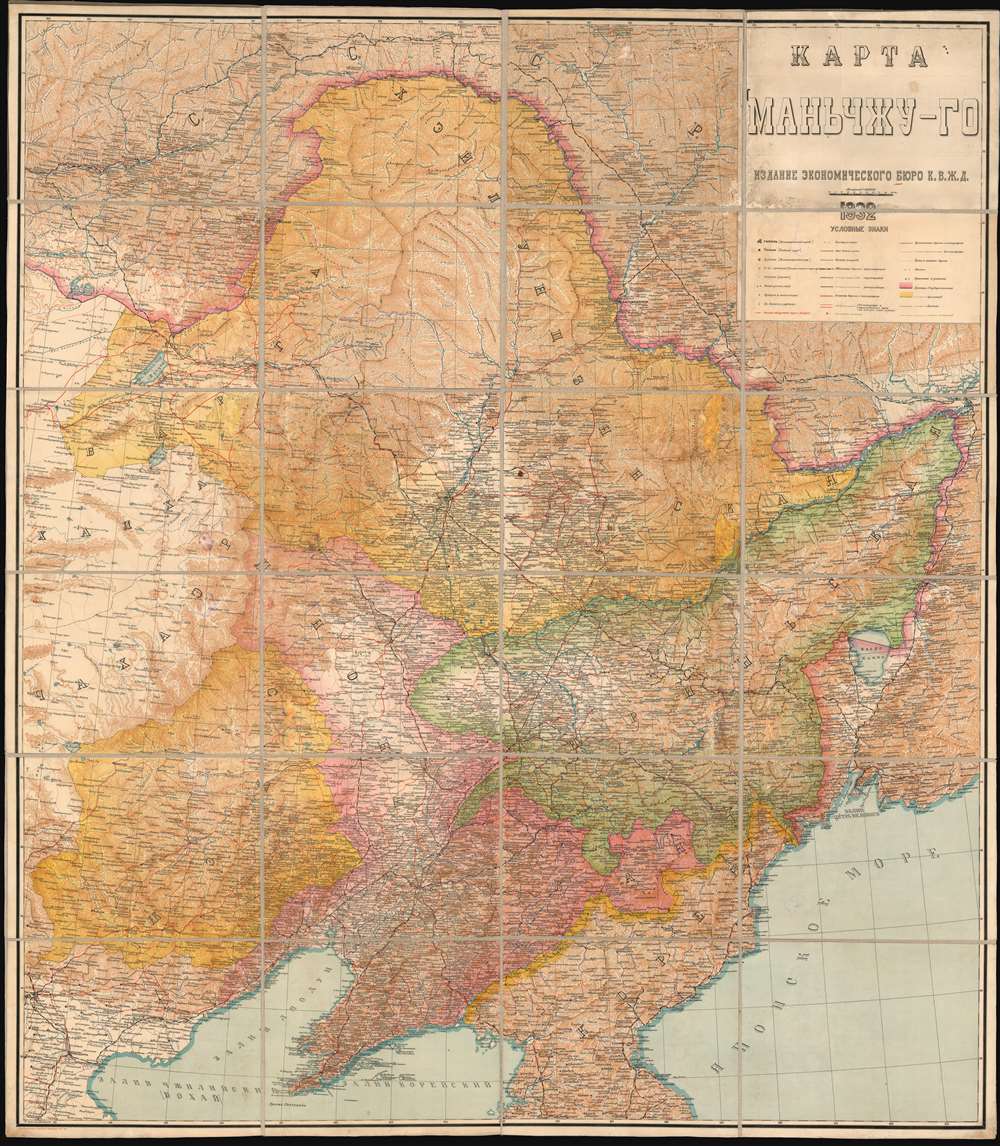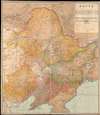This item has been sold, but you can get on the Waitlist to be notified if another example becomes available, or purchase a digital scan.
1932 Economic Bureau of the Soviet Union Wall Map of Manchuria / Manchukuo
Manchukuo-economicbureau-1932$2,750.00

Title
КАРТА МАНЬЧЖУ-ГО. / Manchu-Go Map.
1932 (dated) 72.75 x 63.5 in (184.785 x 161.29 cm) 1 : 1000000
1932 (dated) 72.75 x 63.5 in (184.785 x 161.29 cm) 1 : 1000000
Description
This is a 1932 wall map of Manchuria or Manchukuo published by the Economic Bureau of the Chinese Eastern Railway (abbreviated K.V.Zh.D. in Russian). Entirely in Russian, the map depicts Manchukuo, the name giving to the Japanese puppet state established after the 1932 Japanese invasion of Manchuria. This railroad map was published by the Soviet division of the Chinese Eastern Railway, a vital transport artery critical to Soviet ambitions in East Asia. These railways, the Trans-Siberian Railway and the Chinese Eastern Railway (also known as the Trans-Manchurian Railway), played a pivotal role in the geopolitical upheavals in East Asia during the early 20th century. The publication of this piece by the Soviets, the year Manchukuo was established, underscores the significance control of the railroads had on Soviet psyche and perhaps their premonitions of what was to come.
There was initially some attempt at negotiation between the imperialist powers, but Tsar Nicholas II arrogantly believed it impossible that Japan could challenge a major European power. Japan proved him wrong, launching a surprise attack on the Russian Eastern Fleet stationed at Port Arthur. Throughout the course of the war, the Russians were defeated again and again, humiliating the Tsar and forcing U.S. President Theodore Roosevelt to arbitrate a peace, confirmed by the Treaty of Portsmouth. The treaty recognized Japan's claims on Korea and called for the evacuation of Russian forces from Manchuria, including from Port Arthur.
The overwhelming victory of Imperial Japan came as a surprise to international observers, being the first major military victory in the modern era of an Asian over European power. The consequences transformed the balance of power, confirmed Japan as the pre-eminent power in East Asia.
The Chinese Eastern Railway and the Trans-Siberian Railway
Russian ambitions to connect Moscow with Vladivostok in Siberia began as early as the 1850s. Russia's government wanted to encourage development in Siberia. At that point, rivers and poorly maintained roads provided the only direct connection between the frontiers of the expansive Russian Empire. After decades of rejecting plans and prioritizing other projects, construction on the Trans-Siberian Railway began in March 1891. It opened in 1904, but construction was fully finalized until 1916. The most direct route to Vladivostok included traversing Chinese dominated Manchuria. The Qing Dynasty granted then-Tsarist Russia a concession through Manchuria to construct the railroad. Construction began in 1897 and lasted until 1902, nearly a decade before the route through Russian territory was complete. Thus leaving the Chinese Eastern Railway as critical to Russian plans to develop reach Vladivostok and develop Siberia.Russo-Japanese War
The Russo-Japanese War, fought from February 8, 1904 - September 5, 1905, played a critical role in future power dynamics in Korea and Manchuria. The war pitted Imperial Japan against Tsarist Russia over rival imperial ambitions in Manchuria and Korea. Both Russia and Japan had grand visions for the region. Russia traditionally had only one Pacific port, Vladivostok, which was operational only during the warm summer months. In 1898, Russia coerced China, then weakened after the First Sino-Japanese War (1894 - 1895), to lease Port Arthur, a warm water port on the Liaodang Peninsula. They also negotiated a right-of-way to connect Port Arthur to the China Eastern Railway, which ran from nearby Dalian (Dalny) to Harbin, a stop on the Siberian Railway. Russia, eager to expand southwards from Siberia, considered Port Arthur the cornerstone to a sphere of influence covering China, Manchuria, and Korea. Japan had its own Imperial ambitions and saw itself as the natural overlord in East Asia. Korea and Manchuria in particular were important as steppingstones into China, with its seemly unlimited resources.There was initially some attempt at negotiation between the imperialist powers, but Tsar Nicholas II arrogantly believed it impossible that Japan could challenge a major European power. Japan proved him wrong, launching a surprise attack on the Russian Eastern Fleet stationed at Port Arthur. Throughout the course of the war, the Russians were defeated again and again, humiliating the Tsar and forcing U.S. President Theodore Roosevelt to arbitrate a peace, confirmed by the Treaty of Portsmouth. The treaty recognized Japan's claims on Korea and called for the evacuation of Russian forces from Manchuria, including from Port Arthur.
The overwhelming victory of Imperial Japan came as a surprise to international observers, being the first major military victory in the modern era of an Asian over European power. The consequences transformed the balance of power, confirmed Japan as the pre-eminent power in East Asia.
Sino-Soviet Conflicts
In 1925, Twenty years after the Russo-Japanese War, and after the Bolshevik Revolution and the Russian Civil War, the Soviet Union and China agreed on mutual ownership and operation of the Chinese Eastern Railway. However, due to differences in education and, likely, Soviet desires to gain firm control of the railway, over two-thirds of railway management positions went to Russians. This disparity irked Chinese officials for years. By 1929, after a series of diplomatic miscues and offensive remarks by Soviet diplomats, the Chinese had enough. Chinese authorities tried to remove Soviet managers from positions within the railway's organization and even stormed the Soviet Consulate in Harbin, one of the largest cities on the railway. By July, the Soviets had broken off diplomatic relations and sent an army of over 150,000 to the border region. Fighting began on August 17, 1929, when the Soviets attacked Chalainor. The Soviets suffered heavy losses, but it would not happen again. By late November, after an two-stage Soviet offensive, the Chinese sued for peace. The two powers signed a peace treaty that reestablished the status quo ante of 1924.Aftermath of the Sino-Soviet Conflict, the Mukden Incident, and the Japanese Invasion of Manchuria
The Sino-Soviet Conflict provided the Japanese with a model of effective warfare against China. It also created a power vacuum. Imperial Japan next set its eye on Manchuria. The Mukden Incident, an armed confruntation at Mukden in Manchuria staged by the Japanese military, provided the needed pretext. Japan invaded on September 18, 1931 and secured victory by February 1932, establishing Manchukuo on March 1. Stalin knew that the Soviet Union was not strong enough in the East to oppose Japan's move and elected to adopt a position of neutrality. The Soviets sold their rights to the railway on March 23, 1935 - just three years after this map was made.Publication History and Census
This map was created and published by the Economic Bureau of the Chinese Eastern Railway in 1932. This is the only known surviving example.Condition
Good. Dissected and mounted on linen in twenty-four (24) panels. Exhibits some soiling. Relined with fresh linen. Folds into custom clamshell box.




